Briggs & Stratton 300000, 380000, 350000, 290000 User Manual
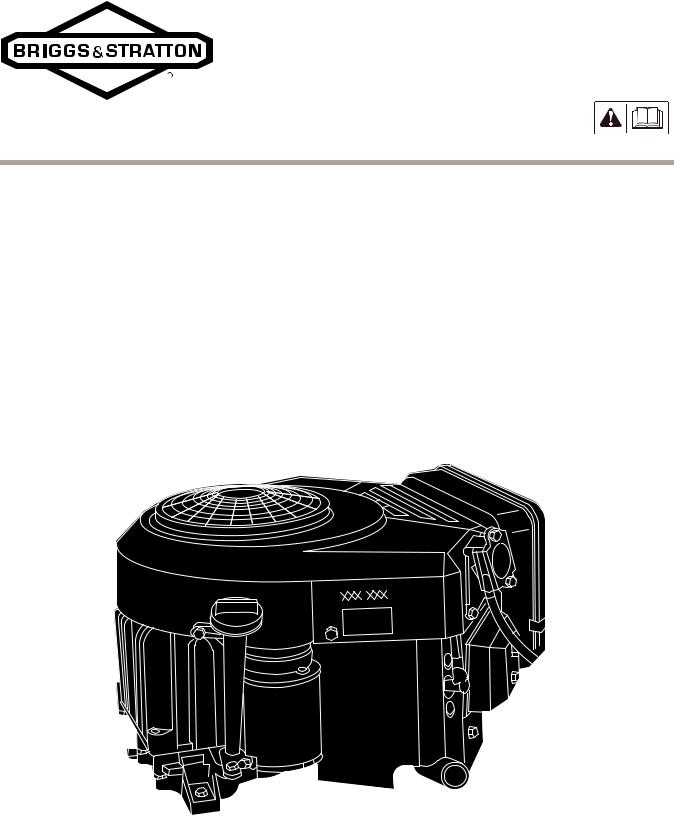
Operator’s Manual
Model 290000 |
|
Vanguard |
Model 350000 |
Vanguard |
|
||||
|
|
|
|
|
Model 300000 |
Vanguard |
Model 380000 |
Vanguard |
|
|
|
|
|
|
|
|
|
ECopyright Briggs & Stratton Corporation |
Form No. 277107-3/07 |
BRIGGSandSTRATTON.com |
Milwaukee, Wisconsin 53201 U.S.A. |
Printed in U.S.A. |
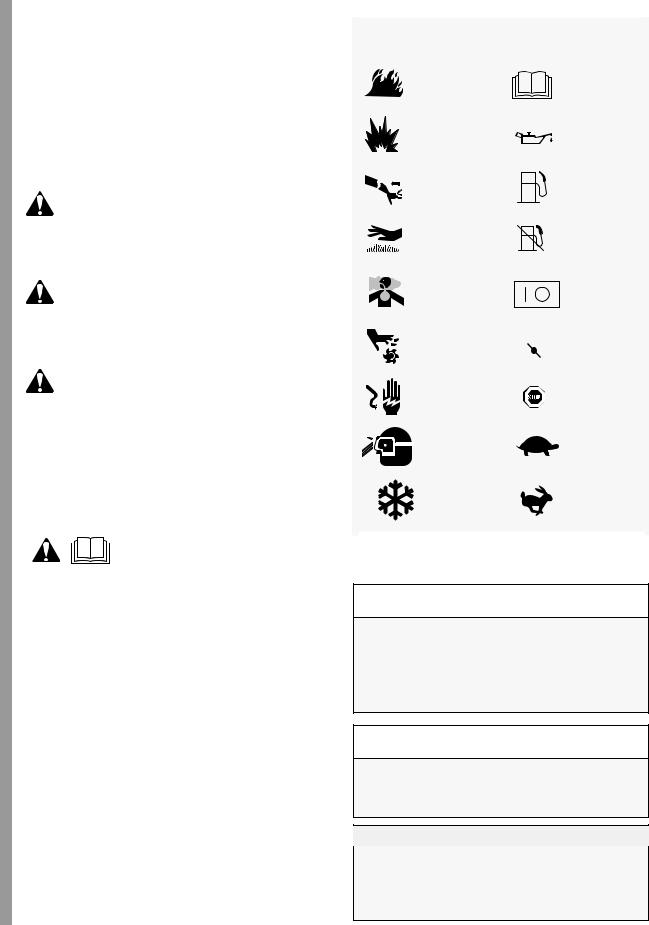
Safety References
The safety alert symbol  is used to identify safety information about hazards that can result in personal injury. A signal word (DANGER, WARNING, or CAUTION) is used with the alert symbol to indicate the likelihood and the potential severity of injury. In addition, a hazard symbol may be used to represent the type of hazard.
is used to identify safety information about hazards that can result in personal injury. A signal word (DANGER, WARNING, or CAUTION) is used with the alert symbol to indicate the likelihood and the potential severity of injury. In addition, a hazard symbol may be used to represent the type of hazard.
DANGER indicates a hazard which, if not avoided, will result in death or serious injury.
WARNING indicates a hazard which, if not avoided, could result in death or serious injury.
CAUTION indicates a hazard which, if not avoided, might result in minor or moderate injury.
CAUTION, when used without the alert symbol, indicates a situation that could result in damage to the engine.
This manual contains safety information to make you aware of
the hazards and risks associated with engines, and how to avoid them. Because Briggs & Stratton does not necessarily know what equipment this engine will power, it is important that you read and understand these instructions and the instructions for the equipment this engine powers.
Table of Contents
Safety References . . . . . . . . . . . . . . . . . . . . . . . . . . . . . . . 2
Features . . . . . . . . . . . . . . . . . . . . . . . . . . . . . . . . . . . . . . . 3
Safety . . . . . . . . . . . . . . . . . . . . . . . . . . . . . . . . . . . . . . . . 4-5
Oil . . . . . . . . . . . . . . . . . . . . . . . . . . . . . . . . . . . . . . . . . . . . . 6
Fuel . . . . . . . . . . . . . . . . . . . . . . . . . . . . . . . . . . . . . . . . . . . 7
Starting . . . . . . . . . . . . . . . . . . . . . . . . . . . . . . . . . . . . . . . . 8
Stopping . . . . . . . . . . . . . . . . . . . . . . . . . . . . . . . . . . . . . . . 9
Troubleshooting . . . . . . . . . . . . . . . . . . . . . . . . . . . . . . . . 10
Maintenance . . . . . . . . . . . . . . . . . . . . . . . . . . . . . . . . . 11-14
Specifications and Emission Information . . . . . . . . . . . 15
Storage and Service . . . . . . . . . . . . . . . . . . . . . . . . . . . . 16
Warranty Information . . . . . . . . . . . . . . . . . . . . . . . . . . . . 17
SYMBOLS ASSOCIATED
WITH THIS ENGINE:
|
|
|
Fire |
|
|
Read |
|
|
|
|
|
|
Manual |
||
|
|
|
Explosion |
|
|
Oil |
|
|
|
|
Kickback |
|
|
|
Fuel |
|
|
|
|
|
|
||
|
|
|
Hot Surface |
|
|
Fuel Shutoff |
|
|
|
|
Toxic Fumes |
|
|
On Off |
|
|
|
|
|
|
|||
|
|
|
|
|
|||
|
|
|
Moving Parts |
|
|
Choke |
|
|
|
|
|
|
|||
|
|
|
|
|
|||
|
|
|
Shock |
|
|
Stop |
|
|
|
|
Wear Eye |
|
|
Slow |
|
|
|
|
Protec- |
|
|
|
|
|
|
|
tion |
|
|
|
|
|
|
|
Frostbite |
|
|
Fast |
|
 WARNING
WARNING
Briggs & Stratton does not approve or authorize the use of these engines on 3-wheel All Terrain Vehicles (ATVs), motor bikes, fun/recreational go-karts, aircraft products or vehicles intended for use in competitive events. Use of these engines in such applications could result in property damage, serious injury (including paralysis), or even death.
 WARNING
WARNING
The engine exhaust from this product contains chemicals known to the State of California to cause cancer, birth defects, or other reproductive harm.
CAUTION
This engine is shipped from Briggs & Stratton without oil. If you start the engine without oil, the engine will be damaged beyond repair and will not be covered under warranty.
2
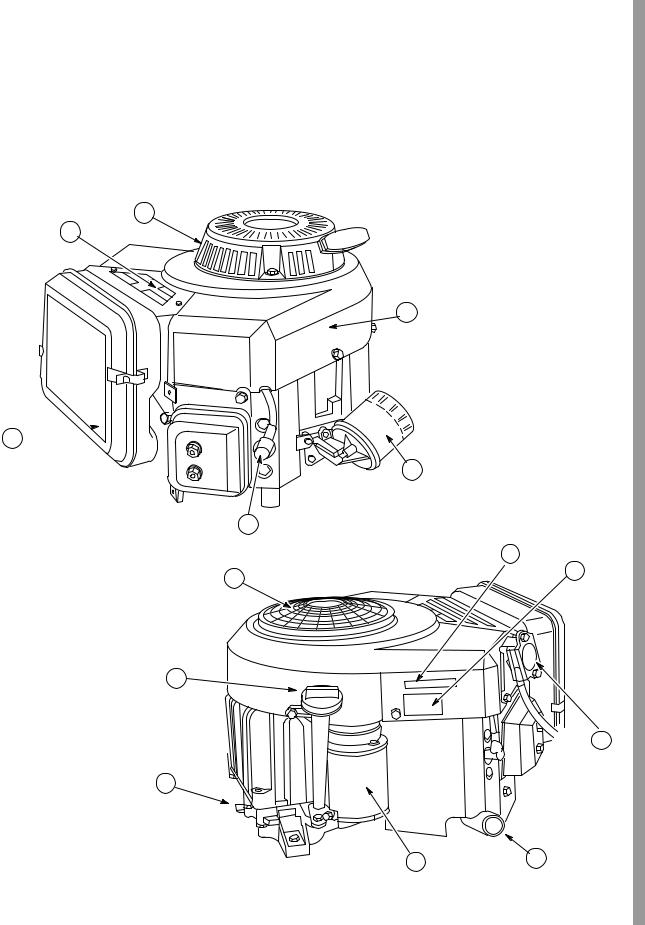
Features
1. |
Air Cleaner |
9. |
Rotating Screen |
2. |
Carburetor or LPG / NG Fuel Mixer |
10. |
Emission Label |
3. |
Rewind Starter (if equipped) |
11. |
Engine Identification |
4. |
Blower Housing |
|
Model XXXXXX Type XXXXXX Code |
5. |
Oil Filter (if equipped) |
|
XXXXXXXX |
|
|
||
6. |
Spark Plug Wire |
12. |
Fuel Pump |
|
|
||
7. |
Oil Drain Plug |
13. |
Exhaust Manifold |
|
|
||
8. |
Oil Fill/Dipstick |
14. |
12V Electric Starter (if |
|
|
||
|
3 |
|
|
|
2 |
|
|
 4
4
1 
|
5 |
|
6 |
|
10 |
9 |
11 |
|
8
12
7
14 |
13 |
3
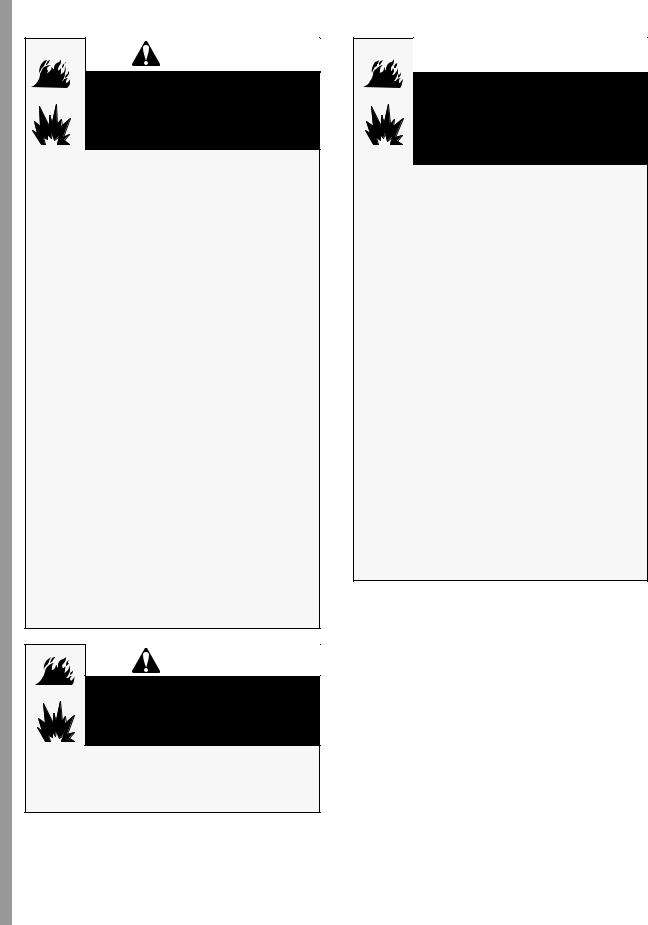
Safety
WARNING |
Gasoline and its vapors are extremely flammable and explosive.
Fire or explosion can cause severe burns or death.
WHEN ADDING FUEL
•Turn engine OFF and let engine cool at least 2 minutes before removing gas cap.
•Fill fuel tank outdoors or in well-ventilated area.
•Do not overfill fuel tank.
•Keep gasoline away from sparks, open flames, pilot lights, heat, and other ignition sources.
•Check fuel lines, tank, cap, and fittings frequently for cracks or leaks. Replace if necessary.
WHEN STARTING ENGINE
•Make sure spark plug, muffler, fuel cap and air cleaner are in place.
•Do not crank engine with spark plug removed.
•If fuel spills, wait until it evaporates before starting engine.
•If engine floods, set choke to OPEN/RUN position, place throttle in FAST and crank until engine starts.
WHEN OPERATING EQUIPMENT
•Do not choke carburetor to stop engine.
WHEN TRANSPORTING EQUIPMENT
•Transport with fuel tank EMPTY.
WHEN STORING GASOLINE OR EQUIPMENT WITH FUEL IN TANK
•Store away from furnaces, stoves, water heaters or other appliances that have pilot light or other ignition source because they can ignite gasoline vapors.
WARNING |
Starting engine creates sparking.
Sparking can ignite nearby flammable gases.
Explosion and fire could result.
•If there is natural or LP gas leakage in area, do not start engine.
•Do not use pressurized starting fluids because vapors are flammable.
 WARNING
WARNING
Gaseous fuels, such as liquid petroleum gas (LPG) and natural gas (NG), are extremely flammable and can readily form explosive air-vapor mixtures at moderate temperatures.
IF YOU SMELL GAS:
•DO NOT start the engine.
•DO NOT actuate any electrical switches.
•DO NOT use the phone in the vicinity.
•Evacuate the area.
•Contact the gas supplier or fire department.
REMEMBER:
•LPG vapor is heavier than air and tends to collect in low areas. NG vapor is lighter then air and tends to collect in high areas. Both may travel to remote locations.
•Keep all flames, sparks, pilot lights and other ignition sources away from the area where the engine is operated or repaired.
•DO NOT smoke when operating or repairing the engine.
•DO NOT store gasoline or other flammable vapors or liquids in the vicinity of the engine.
•BEFORE doing any service work to the engine, shut off the gas supply.
•After initial installation or servicing, check for gas leaks. DO NOT use an open flame. Apply very soapy water or leak test solution with a brush and look for bubbles.
•Keep the equipment and the area surrounding the engine free of debris.
•Install the fuel system according to applicable fuel/gas codes.
4
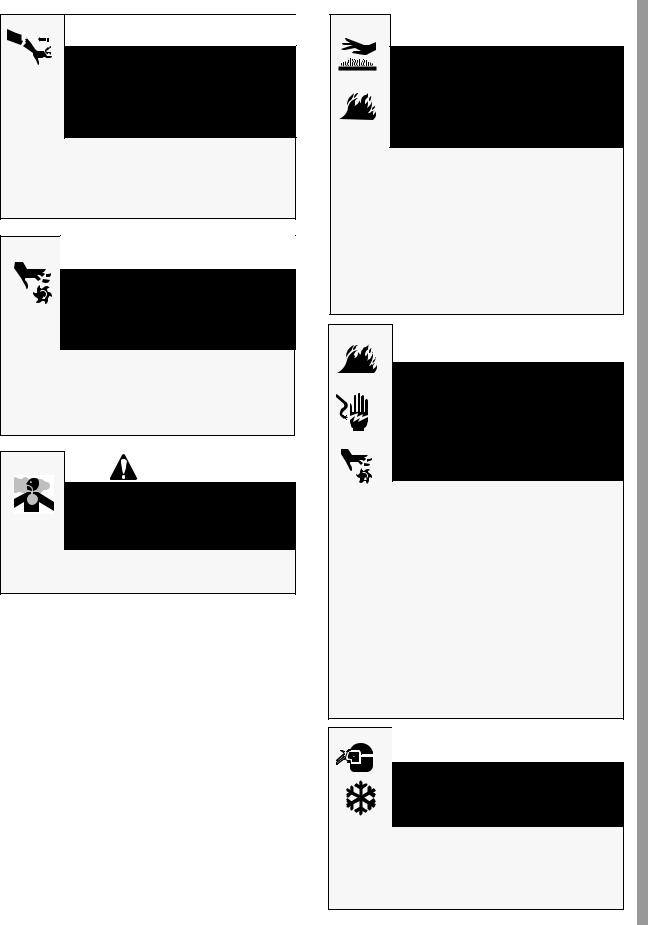
 WARNING
WARNING
Rapid retraction of starter cord (kickback) will pull hand and arm toward engine faster than you can let go.
Broken bones, fractures, bruises or sprains could result.
•When starting engine, pull cord slowly until resistance is felt, then pull rapidly.
•Direct coupled equipment components such as, but not limited to, blades, impellers, pulleys, sprockets, etc., must be securely attached.
 WARNING
WARNING
Rotating parts can contact or entangle hands, feet, hair, clothing, or accessories.
Traumatic amputation or severe laceration can result.
•Operate equipment with guards in place.
•Keep hands and feet away from rotating parts.
•Tie up long hair and remove jewelry.
•Do not wear loose-fitting clothing, dangling drawstrings or items that could become caught.
WARNING |
Engines give off carbon monoxide, an odorless, colorless, poison gas.
Breathing carbon monoxide can cause nausea, fainting or death.
•Start and run engine outdoors.
•Do not start or run engine in enclosed area, even if doors or windows are open.
 WARNING
WARNING
Running engines produce heat. Engine parts, especially muffler, become extremely hot.
Severe thermal burns can occur on contact.
Combustible debris, such as leaves, grass, brush, etc. can catch fire.
•Allow muffler, engine cylinder and fins to cool before touching.
•Remove accumulated debris from muffler area and cylinder area.
•Install and maintain in working order a spark arrester before using equipment on forest-covered, grass-covered, brush-covered unimproved land. The state of California requires this (Section 4442 of the California Public Resources Code). Other states may have similar laws. Federal laws apply on federal land.
 WARNING
WARNING
Unintentional sparking can result in fire or electric shock.
Fire or explosion can cause severe burns or death.
Unintentional start-up can result in entanglement, traumatic amputation, or laceration.
Before performing maintenance or repairs:
•Disconnect spark plug wire and keep it away from spark plug.
•Disconnect battery at negative terminal (only engines with electric start).
•Use only correct tools.
•Do not strike the flywheel with a hammer or hard object because the flywheel may later shatter during operation.
•Do not tamper with governor spring, links or other parts to increase engine speed.
When testing for spark:
•Use approved spark plug tester.
•Do not check for spark with spark plug removed.
 WARNING
WARNING
Wear eye protection when doing repair work.
Frostbite can result from skin/eye contact with leaking LP liquid.
•Installation, adjustment and repair work should be done by a qualified technician.
•Flexible supply lines should be checked regularly to make sure they are in good condition. Replace damaged or leaking components.
5
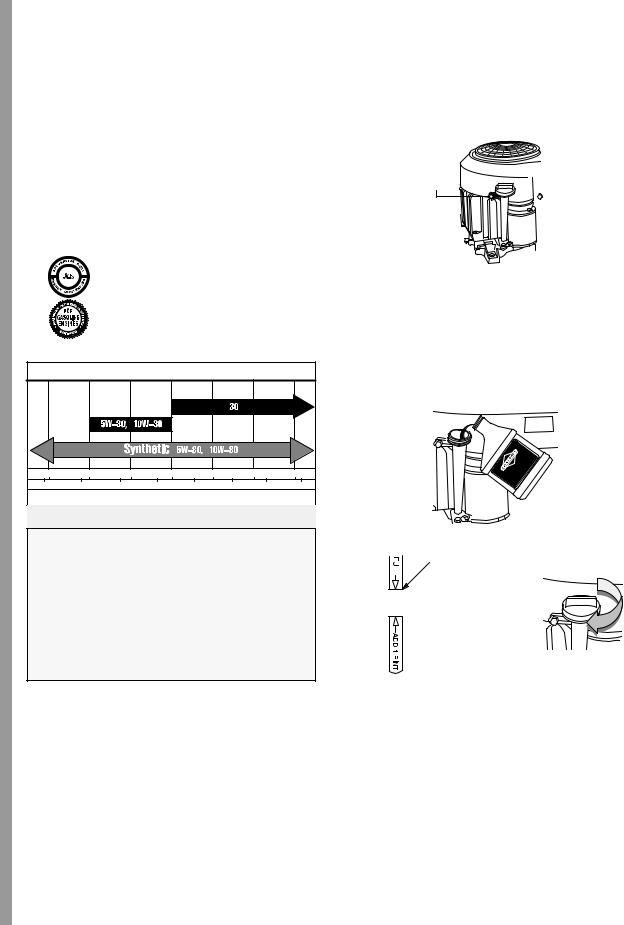
Before Starting
Oil
Oil Capacity
Engine holds approximately 1-1/2 quarts (48 ounces or 1.4 liters) when changing oil and filter.
Oil Recommendation
•Use a high quality detergent oil classified “For Service SF, SG, SH, SJ” or higher. Briggs & Stratton strongly recommends the use of synthetic oil. If synthetic oil is unavailable, Briggs & Stratton non-synthetic 30 weight oil P/N 1000005 (20 oz.) or P/N 1000028 (48 oz.) is an acceptable substitute.
•Do not use special additives.
•Choose a viscosity according to the table below.
Note: Synthetic oil meeting ILSAC
GF-2, API certification mark and API service symbol (shown at left) with “SJ/CF ENERGY CONSERVING” or higher, is an acceptable oil at all temperatures. Use of synthetic oil does not alter required oil change intervals.
SAE Viscosity Grades
|
|
|
** |
|
|
|
|
|
|
|
|
|
|
* |
|
|
|
°F -20 |
0 |
20 |
32 |
40 |
60 |
|
80 |
100 |
°C -30 |
-20 |
-10 |
0 |
|
10 |
20 |
30 |
40 |
STARTING TEMPERATURE RANGE ANTICIPATED BEFORE NEXT OIL
CHANGE
CAUTION
*Air cooled engines run hotter than
automotive engines. The use of
non-synthetic multi-viscosity oils (5W-30, 10W-30, etc.) in temperatures above 40° F (4° C) will result in higher than normal oil consumption. When using a multi-viscosity oil, check oil level more frequently.
**SAE 30 oil, if used below 40° F (4° C), will
result in hard starting and possible engine bore damage due to inadequate lubrication.
Checking and Adding Oil
•Check oil level before starting the engine.
•Keep oil level at FULL. Do not overfill.
•Check level daily, or after every eight (8) hours.
Oil Fill
1.Place engine level and clean around oil fill and dipstick.
2.Remove dipstick and wipe with clean cloth.
3.Tighten dipstick down. Remove and check oil level.
4.Remove oil fill cap. Pour oil slowly. First add 1 qt (32 oz or 1 liter). Start and run engine at idle for 30 seconds. Shut off engine and wait 30 seconds. Then add more oil slowly to bring level to FULL mark on dipstick.
5. Fill to FULL mark on dipstick. Recheck.
FULL
Ï

6. Tighten dipstick firmly.
Oil Pressure Switch
If engine is equipped with oil pressure switch, the switch will either activate a warning device or stop the engine when the engine runs low on oil. (Read the operating instructions supplied by equipment manufacturer to determine how your engine is equipped.)
6
